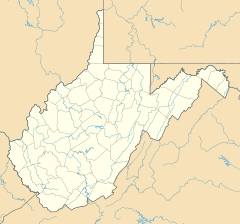Blair, Logan County, West Virginia facts for kids
Quick facts for kids
Blair, West Virginia
|
|
|---|---|
| Country | United States |
| State | West Virginia |
| County | Logan |
| Time zone | UTC-5 (Eastern (EST)) |
| • Summer (DST) | UTC-4 (EDT) |
| FIPS code | 1553921 |
Blair is a small, unincorporated community located in Logan County, West Virginia, in the United States. An "unincorporated community" means it's a place where people live, but it doesn't have its own local government like a city or town. Blair is situated along the Spruce Fork and can be found by following West Virginia Route 17.
Contents
Geography of Blair
Blair is nestled in a valley at the very beginning of the Spruce Fork, which is a branch of the Little Coal River. The community sits right at the base of a famous landmark called Blair Mountain. This mountain is very important because it acts like a natural wall, separating Blair and nearby communities like Sharples and Clothier from the main part of Logan County.
History of Blair Mountain
Blair is most famous for its connection to the Battle of Blair Mountain. This was a major event in American labor history, happening in 1921. It was the largest armed uprising in the United States since the American Civil War.
Why the Battle Happened
In the early 1900s, many people in West Virginia worked in coal mines. Mine owners often had a lot of control over the miners' lives. They paid low wages and working conditions were often dangerous. Miners wanted to join unions to have a stronger voice and improve their lives. However, mine owners often tried to stop them from forming unions.
The Miners' March
In August 1921, thousands of coal miners, many of them armed, began a long march towards Logan County. Their goal was to help other miners who were being prevented from joining unions. They wanted to free miners from the harsh conditions and unfair practices of the coal companies.
The Conflict at Blair Mountain
The miners' march led them to Blair Mountain. Here, they met armed groups hired by the coal companies and local law enforcement. For several days, a large-scale conflict took place. It was a very intense standoff between the miners and those defending the coal company's interests.
Federal Intervention
The situation became so serious that the United States Army had to step in. President Warren G. Harding sent federal troops and even planes to the area. This intervention eventually helped to end the fighting.
Aftermath and Legacy
After the battle, many miners were arrested and put on trial. The unions faced setbacks in the short term. However, the Battle of Blair Mountain brought a lot of attention to the struggles of coal miners. It played an important role in the history of labor rights in the United States, showing the extreme lengths people would go to fight for fair treatment and better working conditions. Today, Blair Mountain is recognized as a historic site, reminding us of this important chapter in American history.
See also
 In Spanish: Blair (condado de Logan) para niños
In Spanish: Blair (condado de Logan) para niños



